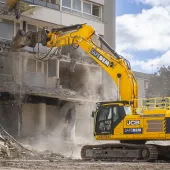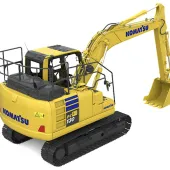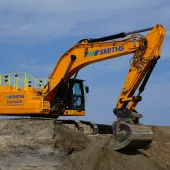JCB reveal world’s first hydrogen-fuelled excavator

Company develops first-ever working prototype of emission-free excavator powered by hydrogen
JCB have developed the construction industry’s first ever hydrogen powered excavator as they continue to lead the sector on zero and low-carbon technologies.
The 20-tonne 220X machine powered by a hydrogen fuel-cell has been undergoing rigorous testing at JCB’s quarry proving grounds for more than 12 months.
The development means JCB have become the first construction equipment company in the world to unveil a working prototype of an excavator powered by hydrogen.
JCB chairman Lord Bamford said: ‘The development of the first hydrogen-fuelled excavator is very exciting as we strive towards a zero-carbon world.
‘In the coming months, we will continue to develop and refine this technology with advanced testing of our prototype machine, and we will continue to be at the forefront of technologies designed to build a zero-carbon future.’
Lord Bamford’s son Jo Bamford spent 14 years at JCB before moving into the hydrogen sector, setting up Ryse Hydrogen and then buying Northern Ireland bus giant Wrightbus.
He has won contracts to supply the world’s first hydrogen double-decker bus to cities such as London and Aberdeen.
Jo Bamford said: ‘I truly believe hydrogen is the UK’s best opportunity to build a world-leading industry which creates UK jobs, cuts emissions and is the envy of the globe.’
Power for JCB’s prototype excavator is generated by reacting hydrogen with oxygen in a fuel-cell to create the energy needed to run electric motors. The only emission from the exhaust is water.
The development comes after JCB made manufacturing history last year by going into full production with the construction industry’s first fully electric mini-excavator, the 19C-1E.
JCB have also extended electric technology to their Teletruk telescopic forklift range with the launch of an electric model, the JCB 30-19E.
JCB have also been leading the way on clean diesel technology to meet Stage V EU emissions regulations and have almost eradicated the most harmful emissions from their latest range of diesel engines, with nitrous oxide (NOx) down by 97%, soot particulates down by 98% and carbon dioxide (CO2) emissions down by almost half.









